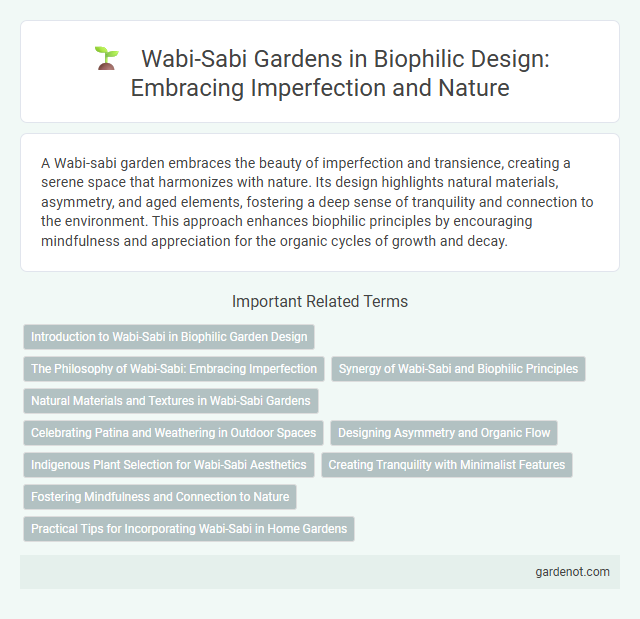A Wabi-sabi garden embraces the beauty of imperfection and transience, creating a serene space that harmonizes with nature. Its design highlights natural materials, asymmetry, and aged elements, fostering a deep sense of tranquility and connection to the environment. This approach enhances biophilic principles by encouraging mindfulness and appreciation for the organic cycles of growth and decay.
Introduction to Wabi-Sabi in Biophilic Garden Design
Wabi-sabi in biophilic garden design embraces natural imperfection, asymmetry, and simplicity to create tranquil outdoor spaces that foster mindfulness and connection to nature. This Japanese aesthetic values weathered textures, muted colors, and organic materials, promoting a harmonious environment that celebrates the beauty of impermanence. Incorporating Wabi-sabi principles enhances biophilic design by reinforcing emotional well-being through the appreciation of nature's authentic, unrefined qualities.
The Philosophy of Wabi-Sabi: Embracing Imperfection
The philosophy of Wabi-Sabi in biophilic design celebrates the beauty found in imperfection, impermanence, and incompleteness, creating a serene and authentic garden environment. This approach emphasizes natural materials, asymmetry, and weathered textures to foster a deep connection with nature's organic cycle and the acceptance of transience. Wabi-Sabi gardens inspire mindfulness by encouraging appreciation for the imperfect and the transient, aligning perfectly with sustainable, nature-centered design principles.
Synergy of Wabi-Sabi and Biophilic Principles
The Wabi-sabi garden embodies the synergy of Wabi-Sabi and biophilic design principles by celebrating natural imperfection and impermanence, fostering a deep connection with the environment. Its asymmetrical patterns, weathered textures, and organic forms enhance psychological well-being through sensory engagement and mindfulness. Integrating Wabi-Sabi aesthetics with biophilic elements promotes ecological harmony and sustainable landscaping practices in contemporary garden design.
Natural Materials and Textures in Wabi-Sabi Gardens
Wabi-sabi gardens emphasize the beauty of imperfection through the use of natural materials like weathered wood, rough stone, and aged bamboo, which evoke a sense of authenticity and timelessness. Textures in these gardens are intentionally raw and unrefined, highlighting the tactile experience and organic origins of each element. Incorporating moss, lichen, and rustic ceramics enhances the sensory connection to nature, fostering a serene and harmonious environment.
Celebrating Patina and Weathering in Outdoor Spaces
Wabi-sabi gardens emphasize the beauty of natural aging, highlighting patina and weathering as essential design elements that evoke tranquility and authenticity. Weathered materials such as stone, wood, and metal develop unique textures and colors over time, creating a dynamic interaction between nature and built environment. This approach fosters a profound connection to impermanence and organic processes, enriching outdoor spaces with visual depth and serene imperfection.
Designing Asymmetry and Organic Flow
A Wabi-sabi garden embraces biophilic design by emphasizing asymmetry and organic flow, reflecting the natural imperfection and impermanence found in nature. Elements like irregular stone paths, weathered textures, and naturally shaped plants create a harmonious, tranquil environment. This design approach fosters a deep connection to the natural world, enhancing well-being through subtle, unforced aesthetics.
Indigenous Plant Selection for Wabi-Sabi Aesthetics
Indigenous plant selection in Wabi-Sabi gardens highlights native species that emphasize natural imperfection, asymmetry, and simplicity, fostering a deep connection to the local environment. These plants, often resilient and low-maintenance, evoke seasonal cycles and subtle beauty, enhancing the garden's tranquil, contemplative atmosphere. By integrating native flora such as mosses, ferns, and uneven grasses, Wabi-Sabi gardens embody authentic ecological harmony and sustainable biophilic design principles.
Creating Tranquility with Minimalist Features
Wabi-sabi gardens embody biophilic design by emphasizing natural simplicity and imperfection to create tranquility. Utilizing minimalist features such as asymmetrical stone arrangements, weathered wood, and sparse plantings promotes a serene, contemplative environment. This design philosophy encourages mindfulness and connection to nature through understated aesthetics and organic textures.
Fostering Mindfulness and Connection to Nature
Wabi-sabi gardens embody the principles of imperfection and impermanence, fostering mindfulness by encouraging visitors to appreciate natural beauty in its raw, unrefined state. These gardens enhance connection to nature through elements like asymmetrical layouts, weathered materials, and subtle textures that evoke tranquility and presence. Integrating wabi-sabi design within biophilic environments supports mental well-being by promoting a deep awareness of natural cycles and the simple, transient moments of life.
Practical Tips for Incorporating Wabi-Sabi in Home Gardens
Incorporate Wabi-sabi principles in home gardens by embracing imperfection through irregular stone paths, asymmetrical plant arrangements, and weathered materials that evoke natural aging. Use muted, earthy tones and native plants to create a serene, unpretentious atmosphere that highlights simplicity and transience. Introduce elements like moss, driftwood, or aged pottery to emphasize the beauty of natural decay and subtle textures in the garden space.
Wabi-sabi garden Infographic

 gardenot.com
gardenot.com